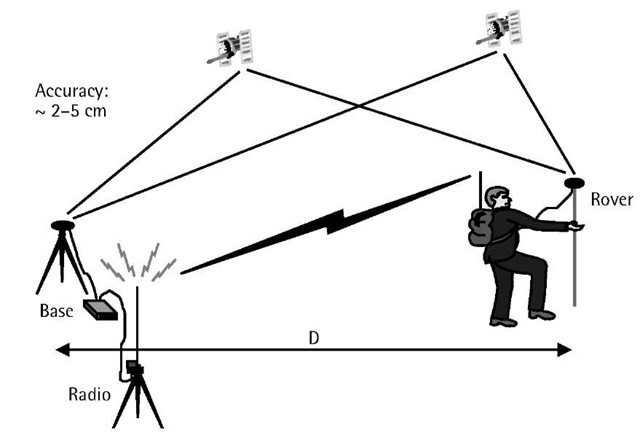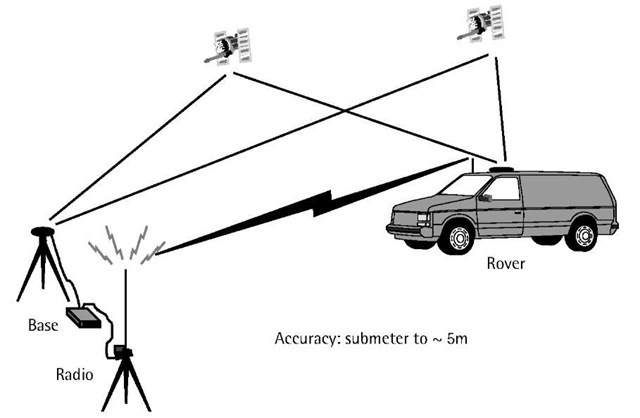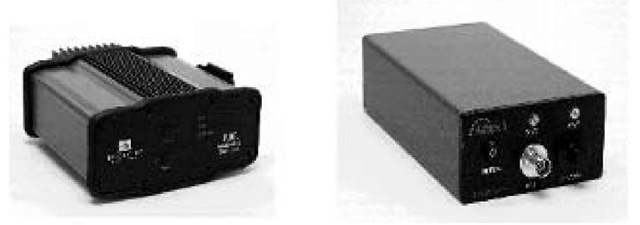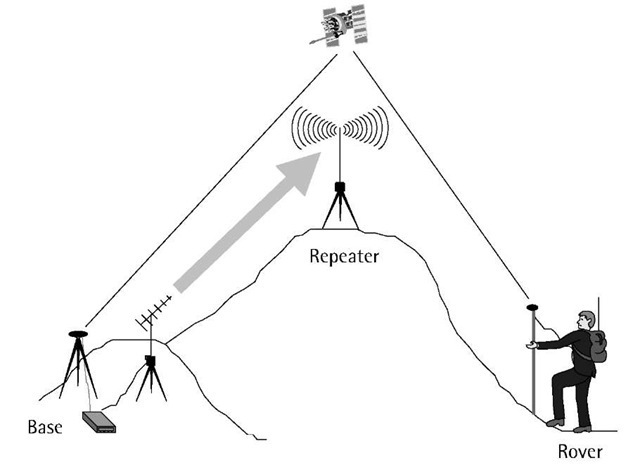RTK GPS
RTK surveying is a carrier phase-based relative positioning technique that, like the previous methods, employs two (or more) receivers simultaneously tracking the same satellites (Figure 5.6). This method is suitable when: (1) the survey involves a large number of unknown points located in the vicinity (i.e., within up to about 10-15 km) of a known point; (2) the coordinates of the unknown points are required in real time; and (3) the line of sight, the propagation path, is relatively unobstructed [6]. Because of its ease of use as well as its capability to determine the coordinates in real time, this method is the preferred method by many users.
Figure 5.6 RTK GPS surveying.
In this method, the base receiver remains stationary over the known point and is attached to a radio transmitter (Figure 5.6). The rover receiver is normally carried in a backpack and is attached to a radio receiver. Similar to the conventional kinematic GPS method, a data rate as high as 1 Hz (one sample per second) is required. The base receiver measurements and coordinates are transmitted to the rover receiver through the communication (radio) link [7, 8]. The built-in software in a rover receiver combines and processes the GPS measurements collected at both the base and the rover receivers to obtain the rover coordinates.
The initial ambiguity parameters are determined almost instantaneously using a technique called on-the-fly (OTF) ambiguity resolution, to be discussed in the next topic. Once the ambiguity parameters are fixed to integer values, the receiver (or its handheld computer controller) will display the rover coordinates right in the field. That is, no postprocessing is required. The expected positioning accuracy is of the order of 2 to 5 cm (rms). This can be improved by staying over the point for a short period of time, for example, about 30 seconds, to allow for averaging the position. The computed rover coordinates for the entire survey may be stored and downloaded at a later time into CAD software for further analysis. This method is used mainly, but not exclusively, with dual-frequency receivers.
Under the same conditions, the positioning accuracy of the RTK method is slightly degraded compared with that of the conventional kinematic GPS method. This is mainly because the time tags (or time stamps) of the conventional kinematic data from both the base and the rover match perfectly in the processing. With RTK, however, the base receiver data reaches the rover after some delay (or latency). Data latency occurs as a result of formatting, packetizing, transmitting, and decoding the base data [7]. To match the time tag of the rover data, the base data must be extrapolated, which degrades the positioning accuracy.
Real-time differential GPS
Real-time differential GPS (DGPS) is a code-based relative positioning technique that employs two or more receivers simultaneously tracking the same satellites (Figure 5.7). It is used when a real-time meter-level accuracy is enough. The method is based on the fact that the GPS errors in the measured pseudoranges are essentially the same at both the base and the rover, as long as the baseline length is within a few hundred kilometers.
Figure 5.7 Real-time differential GPS operation.
As before, the base receiver remains stationary over the known point. The built-in software in the base receiver uses the precisely known base coordinates as well as the satellite coordinates, derived from the navigation message, to compute the ranges to each satellite in view. The software further takes the difference between the computed ranges and the measured code pseudoranges to obtain the pseudorange errors (or DGPS corrections). These corrections are transmitted in a standard format called Radio Technical Commission for Maritime Service (RTCM) to the rover through a communication link.The rover then applies the DGPS corrections to correct the measured pseudoranges at the rover. Finally, the corrected pseudoranges are used to compute the rover coordinates.
The accuracy obtained with this method varies between a submeter and about 5m, depending on the base-rover distance, the transmission rate of the RTCM DGPS corrections, and the performance of the C/A-code receivers [2]. Higher accuracy is obtained with short base-rover separation, high transmission rate, and carrier-smoothed C/A-code ranges. With the termination of selective availability, the data rate could be reduced to 10 seconds or lower without noticeable accuracy degradation. Further accuracy improvement could be achieved if the receivers are capable of storing the raw pseudorange measurements, which could be used at a later time in the postprocessing mode. As the real-time DGPS is widely used, some governmental agencies as well as private firms are providing the RTCM DGPS corrections either at no cost or at certain fees.
Real time versus postprocessing
The term real time means that the results are obtained almost instantaneously, while the term postprocessing means that the measurements are collected in the field and processed at a later time to obtain the results. Each of these modes has some advantages and some disadvantages.
The first advantage of the real-time mode is that the results as well as the accuracy measures (or quality control) are obtained while in the field. This is especially important for RTK surveying, as the user would not store the displayed coordinates unless the ambiguity parameters are shown to be fixed at integer values and centimeter-level accuracy is achieved. This leads to a higher productivity compared with the postprocessing mode, as only enough GPS data to obtain a fixed solution is collected. In addition, processing the GPS data is done automatically in the field by the built-in software. This means that no postprocessing software training is required. The user also saves the time spent in data processing.
There are, however, some advantages in the postprocessing mode as well. The first of these is that more accurate results are generally obtained with the postprocessing mode. One reason for this is more flexibility in editing and cleaning ofthe collected GPS data. As well, there is no accuracy degradation due to data latency, as explained in Section 5.7. Another important advantage is that the communication link problems, such as the relatively unobstructed line-of-sight requirement, are avoided. In some cases, the input parameters, such as the base station coordinates or the antenna height, may contain some errors, which lead to errors in the computed rover coordinates. These errors can be corrected in the postprocessing mode, while they cannot be completely corrected in the real-time mode.
Communication (radio) link
RTK and real-time DGPS operations require a communication, or radio, link to transmit the information from the base receiver to the rover receiver (Figures 5.6 and 5.7). RTK data are typically transmitted at a baud rate of 9,600, while the DGPS corrections are typically transmitted at 200 Kbps. A variety of radio links that use different parts of the electromagnetic spectrum are available to support such operations. The spectrum parts mostly used in practice are the low/medium frequency (LF/MF) bands (i.e., 30 kHz to 3 MHz) and the very high and ultrahigh frequency (VHF/UHF) bands (i.e., 30 MHz to 3 GHz) [7, 8]. Often, GPS users utilize their own dedicated radio links to transmit base station information.
Dedicated ground-based GPS radio links are mostly established using the VHF/UHF band. Radio links in this band provide line-of-sight coverage, with the ability to penetrate into buildings and other obstructions. One example of such a radio link is the widely used RFM96W from Pacific Crest Corporation, which is available in different models based on the supported frequencies in the VHF/UHF band. This type of radio link requires a license to operate. A new radio link that was recently produced by the same company is called the Position Data Link (PDL) (see Figure 5.8). PDL allows for a baud rate of 19,200, and is characterized by low power consumption and enhanced user interface. Another example is the license-free spread-spectrum radio transceiver, which operates in the 902-928 MHz portion of the UHF band (Figure 5.8). This radio link has coverage of 1-5 km and 3-15 km in urban and rural areas, respectively. More recently, some GPS manufacturers adopted cellular technology, the digital Personal Communication Services (PCS), as an alternative communication link. In the near future, it is expected that the third-generation (3G) wideband digital networks will be used extensively as the GPS communication link. The 3G technology uses common global standards, which reduces the service cost. In addition, this technology allows the devices to be kept in the "on" position all the time for data transmission or reception, while the subscribers pay for the packets of data they transmit/receive.
Figure 5.8 Examples of radio modems.
It should be pointed out that obstructions along the propagation path, such as buildings and terrain, attenuate the transmitted signal, which leads to limited signal coverage. The transmitted signal attenuation may also be caused by ground reflection (multipath), the transmitting antenna, and other factors [7]. To increase the coverage of a radio link, a user may employ a power amplifier or high-quality coaxial cables, or he or she may increase the height of the transmitting/receiving radio antenna.
Figure 5.9 Use of repeaters to increase radio coverage.
If a user employs a power amplifier, however, he or she should be cautioned against signal overload, which usually occurs when the transmitting and the receiving radios are very close to each other [7].
A user may also increase the signal coverage by using a repeater station. In this case, it might be better to use a unidirectional antenna, such as a Yagi, at the base station and an omnidirectional antenna at the repeater station (see Figure 5.9) [8].




